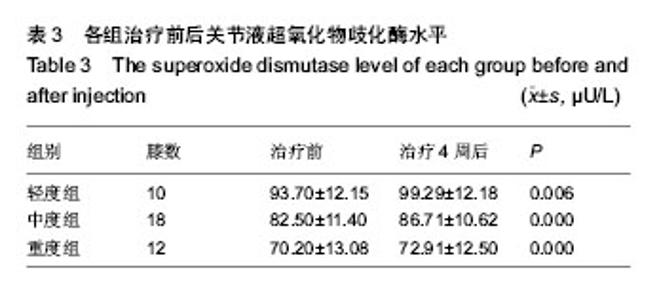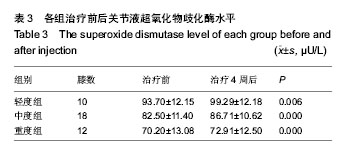| [1] 张乃峥,施金旺,张雪哲.膝骨关节炎的流行病学调查[J].中华内科杂志,2005,34(2):84.
[2] 沈钦荣.循证医学在中医药治疗膝骨性关节炎研究中的应用[J].光明中医,2005,20(6):25-26.
[3] Bagga H, Burkhardt D,Sambrook P, et al. Longterm effects of intraarticular hyaluronan on synovial fluid in osteoarthritis of the knee. J Rheumatol.2006; 33(5):946-950.
[4] Huang MH, Yang RC, Lee CL, et al. Preliminary results of integrated therapy for patients with knee osteoarthritis. Arthritis Rheum.2005;53(6):812-820.
[5] Monfort J, Nacher M, Montell E, et al. Chondroitin sulfate and hyaluronic acid (500-730 kda) inhibit stromelysin-1 synthesis in human osteoarthritic chondrocytes. Drugs Exp Clin Res. 2005;31(2):71-76.
[6] Kawasaki T,Kurosawa H,Ikeda H,et al.Therapeutic home exercise versus intraartieular hyaluronate injection for osteoarthritis of the knee: 6-month prospective randomized open-labeled trial.J Orthop Sci.2009;14(2):182-191.
[7] 张闻生,李保健,李庆富.关节腔内注射透明质酸钠治疗髋关节骨性关节炎对关节液氧自由基的影响[J].河北医药, 2010,32(1): 33-34.
[8] 方舒锴,史晨辉.骨性关节炎发病机制研究进展[J].农垦医学, 2010,32(1):68-70.
[9] Tetik S, Ahmad S, Alturfan AA, et al. Determinnation of oxidant stress in plasma of rheumatoid and primary osteoarthritis patients.Indian J Biochem Biophys. 2010; 47(6):353-358.
[10] Afonso V,champy R,Mitrovic D,et al. Reactive oxygen species and superoxide dismutasees: role in joint diseases.Joint Bone Spine.2007;74(4):324-329.
[11] Chen AF,Davies CM,De LM,et al.Oxidative DNA damage in osteoarthritic porcine articular cartilage.J Cell Physiol. 2008; 217(3):828-833.
[12] Grigolo B,Roseti L,Fiorini M,et al.Enhanced lipid peroxidation in synoviocytes from patients with osteoaarthritis.J Rheumatol. 2003;30(2):345-347.
[13] 许岳,周临东,谢林.骨性关节炎中药治疗相关作用机制的研究进展[J].中医药信息,2011,28(2):114-117.
[14] 金伟,陈廖斌.生物自由基与骨关节炎[J].湖北预防医学杂志, 2002, 13(4):13-14.
[15] 薛铮,陈亚堃,钧强.盐酸氨基葡萄糖对膝骨关节炎患者关节液中MDA和SOD水平的影响[J].中国医师,2012,15(4):541-542.
[16] 李锋,聂喜增,马湘毅.骨性关节炎患者血清和关节液中自由基水平及意义[J].河北医药,2007,29(1):36-37.
[17] 许鹏,张银刚,姚建锋.透明质酸钠治疗膝骨性关节炎的临床效果及分析[J].中国修复重建外科杂志,2005,19(3):210-214.
[18] Uebelhart D, Williams JM. Effects of hyaluronic acid on cartiLage degration. Curt Opin Rheumatol.1999;11:427-435.
[19] 吴夏勃,蒋科卫,温建民.玻璃酸钠在膝骨关节病的临床应用[J].中国生化药物杂志,2005,269(3):176-177.
[20] 刘坚基,刘宝珍,李铁锋.玻璃酸钠关节腔内注射治疗膝节骨性关节炎的疗效观察[J].临床医药实践杂志,2006,15(5):350-351.
[21] 王国选,林文茂,阿力.玻璃酸钠注射治疗膝退行性骨关节炎疗效观察[J].实用骨科杂志,2005,11(6):561-562.
|



